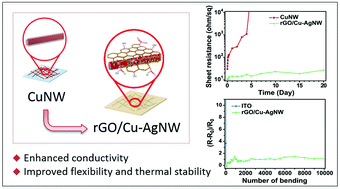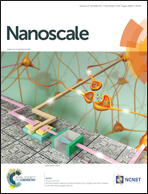Reduced graphene oxide wrapped core–shell metal nanowires as promising flexible transparent conductive electrodes with enhanced stability†
Abstract
Transparent conductive electrodes (TCEs) are widely used in a wide range of optical–electronic devices. Recently, metal nanowires (NWs), e.g. Ag and Cu, have drawn attention as promising flexible materials for TCEs. Although the study of core–shell metal NWs, and the encapsulation/overcoating of the surface of single-metal NWs have separately been an object of focus in the literature, herein for the first time we simultaneously applied both strategies in the fabrication of highly stable Ag–Cu NW-based TCEs by the utilization of Ag nanoparticles covered with reduced graphene oxide (rGO). The incorporation of Ag nanoparticles by galvanic displacement reaction was shown to significantly increase the long term stability of the electrode. Upon comparison with a CuNW reference, our novel rGO/Cu–AgNW-based TCEs unveiled remarkable opto-electrical properties, with a 3-fold sheet resistance decrease (from 29.8 Ω sq−1 to 10.0 Ω sq−1) and an impressive FOM value (139.4). No detrimental effect was noticed in the relatively high transmittance value (T = 77.6% at 550 nm) characteristic of CuNWs. In addition, our rGO/Cu–AgNW-based TCEs exhibited outstanding thermal stability up to 20 days at 80 °C in air, as well as improved mechanical flexibility. The superior performance herein reported compared with both CuNWs and AgNWs, and with a current conventional ITO reference, is believed to highlight the great potential of these novel materials as promising alternatives in optical–electronic devices.



 Please wait while we load your content...
Please wait while we load your content...